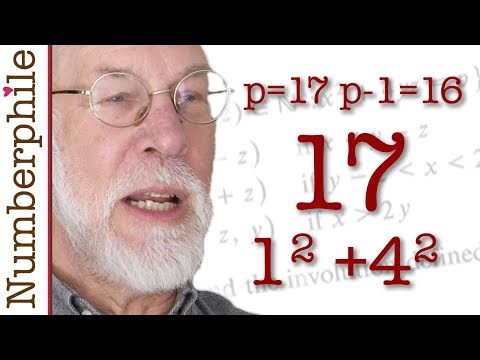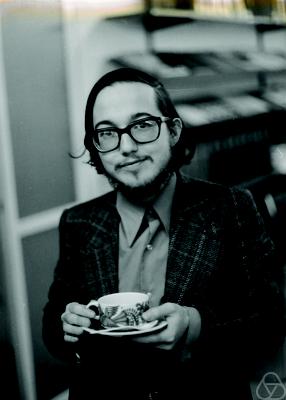In this paper Don Zagier constructs a really short proof of the ver...
Don Zagier, born in 1951, is an American mathematician whose main a...
First we should recall what is an involution. An involution is a fu...
Zagier starts by defining two involutions
$$f(x,y,z) = (x,z,y)$$...
To calculate the fixed points of $g$ we'll have to solve the equati...
Lemma: The cardinalities of a finite set and of its fixed-point se...
To sum up:
Zagier starts by creating a function $g$ which is an ...
THE
TEACHING OF
MATHEMATICS
EDITED BY MELVIN
HENRIKSEN AND
STAN WAGON
A
One-Sentence Proof
That Every Prime
p
1
(mod 4)
Is a Sum of Two
Squares
D.
ZAGIER
Departmenit
of Mathematics,
University of
Maryland, College Park,
MD 20742
The
involution on
the finite set
S
=
{(x,y,z)
E
rkJ3:
X2
+ 4yz
=
p
}
defined by
((x
+
2z,
z, y-x-z)
if
x
<y-z
(x,y,z)
|->4 (2y
-
x,
y, x
-
y
+
z)
if
y
- z <
x < 2y
I(x
-
2y, x
-y
+
z, y)
if
x
>
2y
has
exactly one fixed
point, so
ISI
is odd and the
involution
defined by
(x,y,z)
-
(x,z,y)
also has a fixed
point. O
This
proof is a
simplification of
one due to
Heath-Brown [1]
(inspired,
in
turn, by
a
proof
given by
Liouville).
The verifications of the
implicitly
made assertions-that
S
is
finite and
that the
map
is
well-defined and
involutory
(i.e., equal
to its own
inverse)
and has
exactly
one
fixed
point-are
immediate and
have been left to the
reader.
Only the last
requires that p
be a prime of
the form 4k +
1, the fixed
point
then
being (1,1,k).
Note
that the proof
is not
constructive: it does
not give a
method to
actually find
the
representation
of
p
as a
sum
of two
squares.
A
similar
phenomenon
occurs with
results
in
topology and
analysis that
are proved
using
fixed-point theorems.
Indeed,
the basic
principle we used:
"The
cardinalities of a finite set and of its
fixed-point
set under
any
involution have the same
parity,"
is
a combinatorial
analogue
and
special
case of
the
corresponding
topological
result:
"The Euler characteristics
of
a
topological
space
and of
its
fixed-point
set under
any
continuous involution have
the same
parity."
For a
discussion
of
constructive
proofs
of the
two-squares
theorem,
see the
Editor's Corner elsewhere
in
this issue.
REFERENCE
1. D. R.
Heath-Brown, Fermat's
two-squares
theorem, Invariant
(1984) 3-5.
Inverse
Functions
and their
Derivatives
ERNST SNAPPER
Department of
Mathematics
and Computer
Science,
Dartmouth College,
Hanover, NH 03755
If the concept
of inverse
function
is introduced
correctly,
the usual rule
for its
derivative
is visually
so obvious, it barely
needs
a
proof.
The reason
why
the
standard,
somewhat
tedious
proofs are
given is
that
the inverse
of a function
f(x)
is
144
This content downloaded from 128.120.194.195 on Sun, 21 Jun 2015 04:13:03 UTC
All use subject to JSTOR Terms and Conditions
To calculate the fixed points of $g$ we'll have to solve the equation
$$
g(c)=c
$$
Since $g(S_1)=S_3$,$g(S_3)=S_1$ and $g(S_2)=S_2$ the only fixed points of $g$ must lie in $S_2$.
$$
g(x,y,z) = (2y-x,y,x-y+z)= (x,y,z)
$$
holds if $y=x$, but at the same time $p=x^2+4yz=x(x+4z)$ and so if $p$ is prime the only option is $y=x=1$ and $p=4z+1$. Note that if $x\neq 1$, $p$ would be a product of 2 numbers thus not a prime.
There's also a really well done video by the Numberphile team about this paper
[](https://www.youtube.com/watch?v=SyJlRUBoVp0)
\(c\) is called a "fixed point" of \(f\) because if you start a recursive sequence:
\[a_{n+1}=f(a_{n})\]
\[a_{n+2}=f(a_{n+1})\]
and it reaches \(c\) the sequence will stay fixed at \[a_n = c = f(c)\]
To sum up:
Zagier starts by creating a function $g$ which is an involution in $S$. He finds that $g$ has a fixed point which implies that $p=4z+1$, $z\in \mathbb{N}$. He then uses the lemma about the cardinalities to prove that the other involution $f(x,y,z)=(x,z,y)$ has at least one fixed point. Calculating the fixed point of $f$ we finally get to the result $p=x^2+(2z)^2$, $z,x\in \mathbb{N}$. In other words $p$ is a sum of 2 squares!
I think you mean $g(S_1) = S_3, g(S_3) =S_1$, right?
In this paper Don Zagier constructs a really short proof of the very famous Fermat's theorem on sums of two squares.
Fermat's theorem on sums of two squares says that an odd prime $p$ is expressible as
$$p = x^2 + y^2$$
with $x$ and $y$ integers, if and only if
$$
p \equiv 1 \pmod{4}
$$
which is the same thing as saying if and only if $p=4k+1$, where $k \in \mathbb{N}$.
The prime numbers for which this is true are called Pythagorean primes.
For example, the primes 5, 13, 17, 29, 37 and 41 are all congruent to 1 modulo 4, and they can be expressed as sums of two squares in the following ways:
$$
5 = 1^2 + 2^2 \\
\quad 13 = 2^2 + 3^2\\
\quad 17 = 1^2 + 4^2
$$
Fermat himself claimed to have proven the theorem in a letter to Marin Mersenne in 1640, but didn't provide any proof. The theorem was later solved by several mathematicians including Euler, Gauss, Heath-Brown and Don Zagier.
First we should recall what is an involution. An involution is a function $f$ that is its own inverse:
$$
f(f(x))=x
$$
for all x in the domain of $f$.
A fixed point of a function is an element of the function's domain that is mapped to itself by the function
$$
f(c)=c
$$
From a visual perspective a fixed point is the point where the function intersects the line $y=x$.
Here is an example of a function with 3 fixed points

Lemma: The cardinalities of a finite set and of its fixed-point set under any involution have the same parity.
Proof: Let $S=\{s_1,...,s_n\}$ be the finite set in question. If $s_i$ is not a fixed point then there exists an $s_j$ such that $f(s_i)=s_j$. Note that this forces $f(s_j)=s_i$, so if we delete $s_i$ and $s_j$ from $S$ we obtain a new set $S'$ such that f is an involution in this set, and we have $|S|\equiv |S'|\mod{2}$, in such a manner delete all the non-fixed points, so the result follows.
Using the lemma above and the fact that g has a unique fixed point (so in particular has odd parity), implies that $|S|$ has odd parity, so the number of fixed points of $f$ has odd parity, which means that there is at least one fixed point of $f$.
For $f$, the fixed point equation
$$
f(x,y,z) = (x,z,y)= (x,y,z)
$$
holds if $y=z$ and so $p=x^2+(2z)^2$. We finally proved that $p$ is a sum of 2 squares!
Don Zagier, born in 1951, is an American mathematician whose main area of work is number theory. He was a child prodigy and got a bachelor's and master's degree from MIT at the age of 16 and a PhD from the University of Bonn at the age of 20.

Zagier starts by defining two involutions
$$f(x,y,z) = (x,z,y)$$
$$
g(x,y,z)=\begin{cases}
(x+2z,~z,~y-x-z),\quad \textrm{if}\,\,\, x < y-z \\
(2y-x,~y,~x-y+z),\quad \textrm{if}\,\,\, y-z < x < 2y\\
(x-2y,~x-y+z,~y),\quad \textrm{if}\,\,\, x > 2y
\end{cases}
$$
It's easy to see that $f$ is an involution because
$$
f(f(x,y,z))=f(x,z,y)=(x,y,z)
$$
It's a little more cumbersome to prove that $g(x,y,z)$ is an involution. To do that we first should note that $g$ divides $S$ in 3 regions: $$S_1 = \{(x,y,z) ∈ S : x < y−z \}$$
$$S_2 = \{ (x,y,z) ∈ S : y−z < x <
2y \}$$ $$S_3 = \{ (x,y,z) ∈ S : x > 2y \}$$
such that $S=S_1 \cup S_2 \cup S_3 $.
An interesting property about $g$ is that $g(S_1)=S_3$, $g(S_1)=S_3$, $g(S_2)=S_2$. In other words the solutions of $S_1$ are mapped to $S_3$ and vice-versa and the solutions of $S_2$ are mapped to $S_2$

Let's now prove this for every region:
For $S_1$
$$
g(x,y,z)=(x+2z,z,y-x-z)
$$
To check that $g(S_1)=S_3$ we need to see if the condition $x>2y$ is satisfied. In this case $x>2y \rightarrow x+2z>2z \equiv x>0 $ which is always true since $x \in \mathbb{N}$.
We do the same for $S_3$
$$
g(x,y,z)=(x-2y,x-y+z,y)
$$
To check that $g(S_3)=S_1$ we need to see if the condition $x<y-z$ is satisfied. In this case $x<y-z \rightarrow x-2y<x-y+z-y \equiv z>0 $ which is always true since $z \in \mathbb{N}$.
Finally for $S_2$
$$
g(x,y,z)=(2y-x,y,x-y+z)
$$
To check that $g(S_2)=S_2$ we need to see if the conditions $y-z<x$ and $x<2y$ are satisfied. In this case $y-z<x \rightarrow y-x+y-z<2y-x \equiv z>0 $ and $x<2y \rightarrow 2y-x<2y \equiv x>0 $ which are both true since $z,x \in \mathbb{N}$.
It's now easy to see that $g$ is an involution since:
$$
g(g(S_1))=g(S_3)=S_1
$$
$$
g(g(S_3))=g(S_1)=S_3
$$
$$
g(g(S_2))=g(S_2)=S_2
$$
We should also verify that $g$ maps $S$ into itself, in other words that the image will also satisfy $x^2+4xy = p$. I'm just going to verify that for $S_1$ (for $S_2$ and $S_3$ is exactly the same procedure)
$$
(x+2z)^2+4y(y-x-z)=x^2+4z^2+4xz+4zy-4xz-4z^2=\\
=x^2+4zy \in S
$$